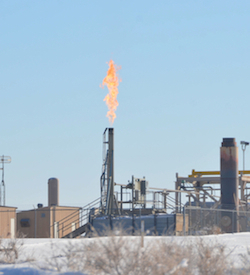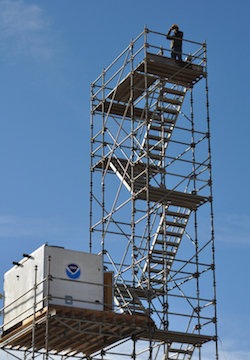2014 News & Events
Wintertime ozone pollution in Utah oil and gas fields
1 October 2014

Chemicals released into the air by oil and gas exploration, extraction and related activities can spark reactions that lead to high levels of ozone in wintertime, high enough to exceed federal health standards, according to new NOAA-led research, published today in Nature.
The study comes at a time when new technologies are helping to accelerate oil and gas development in Utah's Uintah Basin, elsewhere in the United States and in many other countries, and its findings may help air quality managers determine how to best minimize the impact of ozone pollution.
When ozone levels spike, Environmental Protection Agency (EPA) experts recommend that people, especially those in sensitive groups – children, the elderly, and anyone with pre-existing respiratory conditions – limit time outdoors.
Winter ozone pollution is surprising because normally, the more intense sunlight of the summer season can spark the chemical reactions that create ozone pollution, said lead author Peter Edwards, a CIRES scientist working at CSD at the time of the study, now with University of York in England.
However, Edwards and his colleagues showed that in winter in northeastern Utah, levels of volatile organic compounds (VOCs) build high enough that they can trigger pollution-forming reactions themselves. In winter, warm air aloft can trap cold air below, creating an inversion that concentrates VOCs. The presence of snow increases light reflection and accelerates ozone production.
For instance, in 2013, ozone in Ouray, Utah, exceeded the national air quality standards 49 times during the winter season. By contrast, in the densely populated, urban area of Riverside, California, the standards were exceeded about half that amount that same year, but during the summer.
"So it's the same starting ingredients, nitrogen oxides and VOCs, that form ozone in Riverside, but it's a different spark in Utah in winter," said coauthor Steve Brown, a CSD scientist. "Under wintertime conditions, the much higher VOCs in Utah break down to make carbonyl compounds, which set off the ozone production."

The research is based on data collected in a series of wintertime studies in Uintah Basin led by CSD's Jim Roberts. "We encountered a range of conditions during the three winters, from snowy in 2013 and 2014, to virtually no snow in 2012," said Roberts. "Oil and gas emissions of VOCs were high in all three years, but high ozone occurred only in the cold, snowy stagnant periods."
Researchers from NOAA, CIRES, and other institutions made detailed measurements of ozone and the chemical ingredients, such as VOCs and nitrogen oxides, that "cook up" into the pollutant, and they used chemical models to better understand the chemistry behind the wintertime ozone formation.
"These studies in Utah have caused us to think about air pollution chemistry a little differently," said coauthor Joost de Gouw, a CIRES researcher at CSD. "Our findings could help state and local air quality managers who are faced with ozone episodes to design policies, and industry representatives to meet air quality standards in the regions where they operate."
The Utah Department of Environmental Quality (DEQ) was instrumental in providing leadership and coordination, and in securing funding for the three Uintah Basin Winter Ozone Studies (UBWOS). Funding for the studies came from several sources including Utah DEQ and Utah Science Technology and Research Initiative, NOAA, the Western Energy Alliance, the State of Utah, the Bureau of Land Management, the Environmental Protection Agency, the National Science Foundation, QEP Resources, Inc., Utah School and Institutional Trust Lands Administration, and the Uintah Impact Mitigation Special Service District.
Peter M. Edwards, Steven S. Brown, James M. Roberts, Ravan Ahmadov, Robert M. Banta, Joost A. deGouw, William P. Dubé, Robert A. Field, James H. Flynn, Jessica B. Gilman, Martin Graus, Detlev Helmig, Abigail Koss, Andrew O. Langford, Barry L. Lefer, Brian M. Lerner, Rui Li, Shao-Meng Li, Stuart A. McKeen, Shane M. Murphy, David D. Parrish, Christoph J. Senff, Jeffrey Soltis, Jochen Stutz, Colm Sweeney, Chelsea R. Thompson, Michael K. Trainer, Catalina Tsai, Patrick R. Veres, Rebecca A. Washenfelder, Carsten Warneke, Robert J. Wild, Cora J. Young, Bin Yuan and Robert Zamora, High winter ozone pollution from carbonyl photolysis in an oil and gas basin, Nature, doi:10.1038/nature13767, 2014.
Abstract
The United States is now experiencing the most rapid expansion in oil and gas production in four decades, owing in large part to implementation of new extraction technologies such as horizontal drilling combined with hydraulic fracturing. The environmental impacts of this development, from its effect on water quality to the influence of increased methane leakage on climate, have been a matter of intense debate. Air quality impacts are associated with emissions of nitrogen oxides (NOx = NO + NO2) and volatile organic compounds (VOCs), whose photochemistry leads to production of ozone, a secondary pollutant with negative health effects. Recent observations in oil- and gas-producing basins in the western United States have identified ozone mixing ratios well in excess of present air quality standards, but only during winter. Understanding winter ozone production in these regions is scientifically challenging. It occurs during cold periods of snow cover when meteorological inversions concentrate air pollutants from oil and gas activities, but when solar irradiance and absolute humidity, which are both required to initiate conventional photochemistry essential for ozone production, are at a minimum. Here, using data from a remote location in the oil and gas basin of northeastern Utah and a box model, we provide a quantitative assessment of the photochemistry that leads to these extreme winter ozone pollution events, and identify key factors that control ozone production in this unique environment. We find that ozone production occurs at lower NOx and much larger VOC concentrations than does its summertime urban counterpart, leading to carbonyl (oxygenated VOCs with a C = O moiety) photolysis as a dominant oxidant source. Extreme VOC concentrations optimize the ozone production efficiency of NOx. There is considerable potential for global growth in oil and gas extraction from shale. This analysis could help inform strategies to monitor and mitigate air quality impacts and provide broader insight into the response of winter ozone to primary pollutants.